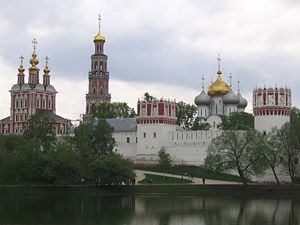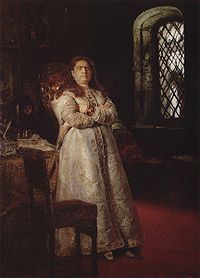- Novodevichy Convent
-
Ensemble of the Novodevichy Convent * UNESCO World Heritage Site
Country  Russian Federation
Russian FederationType Cultural Criteria i, iv, vi Reference 1097 Region ** Europe and North America Inscription history Inscription 2004 (28th Session) * Name as inscribed on World Heritage List
** Region as classified by UNESCONovodevichy Convent, also known as Bogoroditse-Smolensky Monastery (Russian: Новоде́вичий монасты́рь, Богоро́дице-Смоле́нский монасты́рь) is probably the best-known cloister of Moscow. Its name, sometimes translated as the New Maidens' Monastery, was devised to differ from an ancient maidens' convent within the Moscow Kremlin. Unlike other Moscow cloisters, it has remained virtually intact since the 17th century. In 2004, it was proclaimed a UNESCO World Heritage Site.
Contents
Muscovite period
The Novodevichy Convent was founded in 1524 by Grand Prince Vasili III in commemoration of the conquest of Smolensk in 1514. It was built as a fortress at a curve of the Moskva River and became an important part of the southern defensive belt of the capital, which had already included a number of other monasteries. Upon its founding, the Novodevichy Convent was granted 3,000 rubles and the villages of Akhabinevo and Troparevo. Ivan the Terrible would later grant a number of other villages to the convent.
The Novodevichy Convent was known to have sheltered many ladies from the Russian royal families and boyar clans, who had been forced to take the veil, such as Feodor I's wife Irina Godunova (she was there with her brother Boris Godunov until he became a ruler himself), Sophia Alekseyevna (Peter the Great's sister), Eudoxia Lopukhina (Peter the Great's first wife), and others. In 1610–1611, the Novodevichy Convent was captured by a Polish unit under the command of Aleksander Gosiewski. Once the convent was retaken by Russian forces, the tsar supplied it with permanent guards (100 Streltsy in 1616, 350 soldiers in 1618). By the end of the 17th century, the Novodevichy Convent possessed 36 villages (164,215 desyatinas of land) in 27 uyezds of Russia. In 1744, it owned 14,489 peasants.
Imperial period
In the mid-17th century, nuns from other monasteries in the Ukrainian and Belarusian were transferred to Novodevichy Convent. In 1721, some of the aged nuns, who renounced the Old Believers movement, were given shelter. In 1724, the convent also housed a military hospital for the soldiers and officers of the Imperial Russian Army and an orphanage for female foundlings. By 1763, the convent housed 84 nuns, 35 lay sisters, and 78 sick patients and servants. Each year, the state provided the Novodevichy Convent with 1,500 rubles, 1,300 quarters of bread, and 680 rubles and 480 quarters of bread for more than 250 abandoned children.
In 1812, Napoleon's army made an attempt to blow up the convent, but the nuns managed to save the cloister from destruction. In Tolstoy's War and Peace, Pierre was to be executed under the convent walls. In another novel of his, Anna Karenina, Konstantin Lyovin (the main character) meets his future wife Kitty ice-skating near monastery walls. Indeed, the Maiden's Field (as a meadow in front of the convent came to be known) was the most popular skating-rink in 19th-century Moscow. Tolstoy himself enjoyed skating here, when he lived nearby, in the district of Khamovniki.
In 1871, the Filatyev brothers donated money for a shelter-school for the orphans of "ignoble origins". Also, the convent housed two almshouses for nuns and lay sisters. In early 1900s, the Cathedral was surveyed and restored by architect and preservationist Ivan Mashkov. By 1917, there were 51 nuns and 53 lay sisters residing in the Novodevichy Convent.
Soviet period and beyond
In 1922, the Bolsheviks closed down the Novodevichy Convent (the cathedral was the last to be closed, in 1929) and turned it into the Museum of Women's Emancipation. By 1926, the monastery had been transformed into a history and art museum. In 1934, it became affiliated with the State Historical Museum. Most of its facilities were turned into apartments, which spared the convent from destruction.
In 1943, when Stalin started to make advances to the Russian Orthodox Church during World War II, he sanctioned opening the Moscow Theological Courses at the convent. Next year the program was transformed and became the Moscow Theological Institute. In 1945, the Soviets returned Assumption Cathedral to the believers. The residence of the Metropolitan of Krutitsy and Kolomna has been located in the Novodevichy Convent since 1980.
In 1994, nuns returned to the convent, which is currently under the authority of the Metropolitan of Krutitsy and Kolomna. Some of the churches and other monastic buildings are still affiliated with the State Historical Museum. In 1995, religious resumed services in the convent on patron saint's days.
Monuments
 Tsarevna Sofia Alekseyevna at the Novodevichy Convent (1879), by Ilya Repin.
Tsarevna Sofia Alekseyevna at the Novodevichy Convent (1879), by Ilya Repin.
The oldest structure in the convent is the six-pillared five-domed cathedral, dedicated to the icon Our Lady of Smolensk. Extant documents date its construction to 1524–1525; yet its lofty ground floor, magisterial proportions, and projecting central gable are typical of monastery cathedrals built at the behest of Ivan the Terrible. Most scholars agree that the cathedral was rebuilt in the 1550s or 1560s; it was formerly ringed by four smaller chapels, in an arrangement reminiscent of the Annunciation Cathedral in the Kremlin. Its frescos are among the finest in Moscow.
The cathedral may be a focal point of the convent, but there are many other churches. Most date from the 1680s, when the convent was thoroughly renovated at the behest of the regent Sophia Alexeyevna (who, ironically, would be incarcerated there later). The blood-red walls and crown-towers, two lofty over-the-gates churches, a refectory, and residential quarters were all designed in the Muscovite Baroque style, supposedly by a certain Peter Potapov. In the old cathedral, a new bowl for holy water and gilded carved iconostasis were installed in 1685. Its four tiers contain 16th-century icons endowed by Boris Godunov; the fifth tier displays icons by leading 17th-century painters, Simeon Ushakov and Fyodor Zubov.
An arresting slender belltower, also commissioned by Sophia, was built in six tiers to a height of 72 metres (236 ft), making it the tallest structure in 18th-century Moscow (after the Ivan the Great Bell Tower in the Kremlin). This light octagonal column seems to unite all major elements of the ensemble into one harmonious whole.
Cemetery
Main article: Novodevichy CemeteryLike other Moscow monasteries (notably the Danilov and the Donskoy) the New Maidens' Monastery was coveted by the Russian nobility as a place of burial. Sergey Solovyov and Alexei Brusilov are only two of the many prominent Muscovites buried within convent walls. The Napoleonic hero Denis Davydov is also buried in the grounds. In 1898, the so-called Novodevichy Cemetery was opened without monastery walls. Anton Chekhov was one of the first notables to be interred at the new necropolis, and Nikolai Gogol was later reburied there too. During the Soviet epoch, it was turned into the most high-profile cemetery in the Soviet Union, with the likes of Peter Kropotkin, Nikita Khrushchev, Sergei Prokofiev, Dmitri Shostakovich, Konstantin Stanislavski, Boris Yeltsin, and Mstislav Rostropovich being interred there.
External links
References
- Harrison, Peter. Castles of God: Fortified Religious Buildings of the World. Boydell Press (2004) ISBN 1843830663
- Semler, Helen. Discovering Moscow: Architecture, History, and Art. Hippocrene Books (1987) ISBN 0870521314
Monasteries and convents of Moscow Downtown Monasteries: Bogoyavlensky · Chudov1 · Sretensky · Vysokopetrovsky · Zaikonospassky · Zlatoustovsky
Convents: Ivanovsky · Marfo-Mariinsky · Rozhdestvensky · Voznesensky · Zachatyevsky
Outer ring Andronikov · Danilov · Donskoy · Krutitsy · Nikolsky · Pokrovsky · Novodevichy · Novospassky · Perervinsky · Simonov · Ugreshsky 1Destroyed monasteries are in italics World Heritage Sites in Russia by federal district
World Heritage Sites in Russia by federal district




Central - Church of the Ascension in Kolomenskoye
- Moscow Kremlin and Red Square
- Novodevichy Convent
- Trinity Sergius Lavra
- White Monuments of Vladimir and Suzdal
- Historic Centre of Yaroslavl





Southern Northwestern Far Eastern - Volcanoes of Kamchatka
- Central Sikhote-Alin
- Wrangel Island
Siberian Volga North Caucasian Coordinates: 55°43′34″N 37°33′22″E / 55.72611°N 37.55611°E
Categories:- 1524 establishments
- 1680s architecture
- Christian monasteries established in the 16th century
- Monasteries in Moscow
- Religious organizations established in the 1520s
- Russian Orthodox monasteries
- Baroque architecture in Russia
- World Heritage Sites in Russia
Wikimedia Foundation. 2010.


